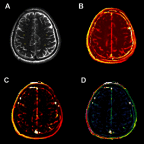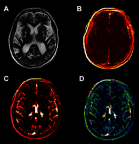The relationship between blood-brain barrier permeability and enlarged perivascular spaces: a cross-sectional study
- PMID: 31190773
- PMCID: PMC6519012
- DOI: 10.2147/CIA.S204269
The relationship between blood-brain barrier permeability and enlarged perivascular spaces: a cross-sectional study
Abstract
Purpose: Enlarged perivascular spaces (EPVS) have been widely considered as a feature of cerebral small vessel disease (cSVD) but the pathogenesis of EPVS remains unclear. Compromised blood-brain barrier (BBB) integrity may play a role since previous studies have shown that BBB breakdown is a critical contributor to the pathogenesis of other cSVD markers. This study aimed to investigate the association of EPVS in the centrum semiovale (CSO) and basal ganglia (BG) with BBB permeability. Patients and methods: Consecutive participants free of symptomatic stroke history presented for physical examination were enrolled in this cross-sectional study. CSO- and BG-EPVS on T2-weighted (T2-W) magnetic resonance imaging (MRI) were rated using a five-point validated scale. Dynamic contrast-enhanced (DCE)-MRI and Patlak pharmacokinetic model were applied to quantify BBB permeability in the CSO and BG. Results: A total of 109 participants aged 49-90 years (mean age of 69.85 years) were enrolled. The proportions of participants presenting high-grade (>10) EPVS in the CSO and BG were 50.5% and 44.0%, respectively. After adjustments for potential confounders by logistic regression, leakage rate and fractional blood plasma volume were correlated with the severity of BG-EPVS (OR: 5.33; 95%CI: 1.95-14.60 and OR: 0.93; 95%CI: 0.87-0.99). Conclusion: Our study demonstrates that BG-EPVS are associated with compromised BBB integrity, supporting the hypothesis that the BBB dysfunction may be involved in the pathogenesis of BG-EPVS. EPVS in the CSO and BG may have distinct pathophysiology.
Keywords: DCE; MRI; blood–brain barrier; cerebral small vessel disease; dynamic contrast-enhanced; enlarged perivascular spaces; magnetic resonance imaging.
Conflict of interest statement
The authors report no conflicts of interest in this work.
Figures


Similar articles
-
Higher ambulatory systolic blood pressure independently associated with enlarged perivascular spaces in basal ganglia.Neurol Res. 2017 Sep;39(9):787-794. doi: 10.1080/01616412.2017.1324552. Epub 2017 May 5. Neurol Res. 2017. PMID: 28475469
-
Enlarged Perivascular Spaces Are Independently Associated with High Pulse Wave Velocity: A Cross-Sectional Study.J Alzheimers Dis. 2024;101(2):627-636. doi: 10.3233/JAD-240589. J Alzheimers Dis. 2024. PMID: 39213072 Free PMC article.
-
Enlarged perivascular spaces correlate with blood-brain barrier leakage and cognitive impairment in Alzheimer's disease.J Alzheimers Dis. 2025 Mar;104(2):382-392. doi: 10.1177/13872877251317220. Epub 2025 Feb 9. J Alzheimers Dis. 2025. PMID: 39924914
-
Factors associated with the location of perivascular space enlargement in middle-aged individuals undergoing brain screening in Japan.Clin Neurol Neurosurg. 2022 Dec;223:107497. doi: 10.1016/j.clineuro.2022.107497. Epub 2022 Nov 2. Clin Neurol Neurosurg. 2022. PMID: 36356441 Review.
-
Enlarged Perivascular Spaces and Dementia: A Systematic Review.J Alzheimers Dis. 2019;72(1):247-256. doi: 10.3233/JAD-190527. J Alzheimers Dis. 2019. PMID: 31561362 Free PMC article.
Cited by
-
Alterations of the Whole Cerebral Blood Flow in Patients With Different Total Cerebral Small Vessel Disease Burden.Front Aging Neurosci. 2020 Jun 23;12:175. doi: 10.3389/fnagi.2020.00175. eCollection 2020. Front Aging Neurosci. 2020. PMID: 32655393 Free PMC article.
-
Distribution of perivascular spaces distribution and relate to the clinical features of SCA3.Orphanet J Rare Dis. 2025 Aug 11;20(1):423. doi: 10.1186/s13023-025-03954-3. Orphanet J Rare Dis. 2025. PMID: 40790774 Free PMC article.
-
High baseline perivascular space volume in basal ganglia is associated with attention and executive function decline in Parkinson's disease.Brain Behav. 2024 Jul;14(7):e3607. doi: 10.1002/brb3.3607. Brain Behav. 2024. PMID: 39010690 Free PMC article.
-
[Alzheimer Dementia and Microvascular Pathology: Blood-Brain Barrier Permeability Imaging].Taehan Yongsang Uihakhoe Chi. 2020 May;81(3):488-500. doi: 10.3348/jksr.2020.81.3.488. Epub 2020 May 29. Taehan Yongsang Uihakhoe Chi. 2020. PMID: 36238621 Free PMC article. Review. Korean.
-
Enlarged perivascular spaces are associated with decreased brain tau deposition.CNS Neurosci Ther. 2023 Feb;29(2):577-586. doi: 10.1111/cns.14040. Epub 2022 Dec 5. CNS Neurosci Ther. 2023. PMID: 36468423 Free PMC article.
References
-
- Ding J, Sigurethsson S, Jonsson PV, et al. Large perivascular spaces visible on magnetic resonance imaging, cerebral small vessel disease progression, and risk of dementia: the age, gene/environment Susceptibility-Reykjavik study. JAMA Neurol. 2017. doi:10.1001/jamaneurol.2017.1397 - DOI - PMC - PubMed
MeSH terms
Substances
LinkOut - more resources
Full Text Sources

